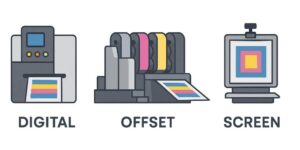چرا در چاپ از CMYK استفاده می شود؟
چاپ CMYK در این صنعت ( صنعت چاپ ) یک مورد استاندارد به حساب می آید. دلیل استفاده از CMYK در چاپ کردن به توضیح خود رنگ ها باز می گردد. CMY در مقایسه با RGB طیف رنگ های روشن تر را آسان تر پوشش می دهد. با این وجود، CMY به خودی خود نمی تواند رنگ های تیره ای مانند “مشکی واقعی” را بوجود بیاورد بنابراین مشکی (“K” نشان دهنده “رنگ کلیدی” است). این مسئله باعث می شود که CMY در مقایسه با RGB طیف رنگی گسترده تری داشته باشد.
استفاده از CMYK ( آبی دریایی ، سُرخابی، زرد و مشکی ) برای پرینترها به پای ثابت چاپ کردن تبدیل شده است. اما دلیل چرایی استفاده CMYK در پرینت کردن چندان شناخته شده نیست ( حتی برای بسیاری از طراحان گرافیک ).
در ظاهر منطقی به نظر نمی رسد. احتمالا در دبستان آموخته اید که رنگ های اصلی شامل قرمز، سبز و آبی (RGB) هستند و تمامی رنگ های دیگر از این سه مورد مشتق شده اند. در نهایت، مانیتورها، پروژکتورها و دستگاه های تلویزیون برای بوجود آوردن تمامی رنگ های دیگر از RGB ( قرمز، سبز و آبی ) استفاده می کنند. ترکیب کردن برخی از این رنگ ها، رنگ های ثانوی را بوجود می آورد ( آبی دریایی، سُرخابی و زرد ). ترکیب تمامی آنها با هم رنگ سفید را بوجود می آورد.
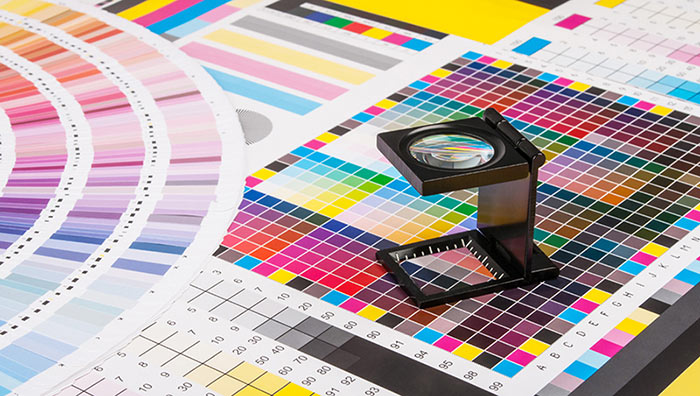
با این وجود، رنگ های اصلی یک مسئله دلبخواهی هستند. مدل های رنگی دیگری وجود دارند و تئوری رنگ ها بسیار پیچیده است. با این حال، بخشی به خاطر دلایل تاریخی و بیشتر بدلیل تاریک بودن اغلب نمایشگرهای الکترونیکی، ما از مدل رنگ RGB برای دستگاه های تصویری تولید کننده نور مانند مانیتورها و پروژکتورها استفاده می کنیم. ترکیب نور قرمز، سبز و آبی رنگ های روشنتری را بوجود می آورد و کنتراست بهتری را برای نمایشگرهای تاریک ارائه می کند.
تمامی مسائل مورد اشاره این پرسش را بوجود می آورند.
چرا ما از جوهرهای RGB در پرینترها استفاده نمی کنیم؟
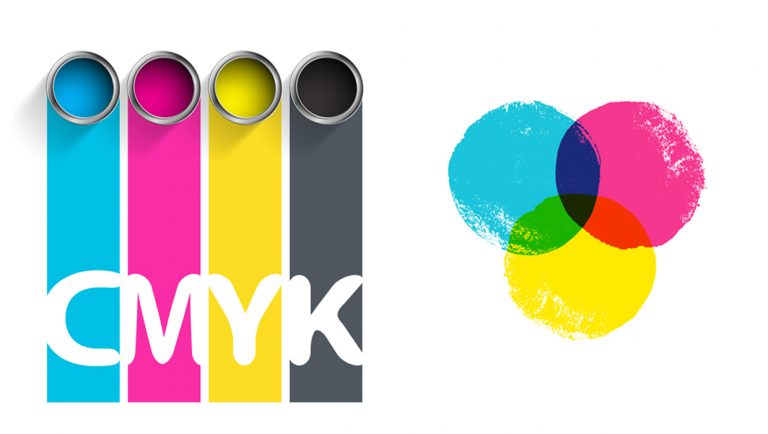
در حالی که تعداد مشخصی از پرینترهای کمیاب وجود دارند که از RGB استفاده می کنند، دلایل کاربردی بیشماری وجود دارد که چاپ CMYK برای مدت طولانی مدل غالب خواهد بود. برای درک این مسئله که چرا پرینترها عموما از RGB استفاده نمی کنند، باید با چند مورد آشنا باشیم. در یک مانیتور یا پروژکتور، ترکیب نورهای رنگی RGB رنگ های روشن تر فوق العاده ای را بوجود می آورد ( در صورت استفاده از نمایشگر تاریک، عالی خواهد بود ).
با این حال، در محصولات چاپ شده، رنگ ها به شکلی متفاوت از تولیدشان در مانیتور کامپیوتر بوجود می آیند. روی هم قرار دادن یا نزدیک به هم قرار دادن جوهرهای RGB بدلیل اینکه جوهرها تنها می توانند رنگ های مختلف طیف رنگی را جذب یا منعکس کنند ( و نه اینکه آنها را آزاد کنند )، رنگ های تیره تری را تولید می کند. در کل، رنگ های RGB تیره هستند. این مسئله باعث می شود تا تولید رنگ های روشن تری مانند زرد یا سبز لیمویی سخت باشد به این خاطر که افزودن رنگ های RGB به شکل اجتناب ناپذیری به رنگ های تیره تر منجر می شود.
چرایی استفاده از مدل رنگ CMYK
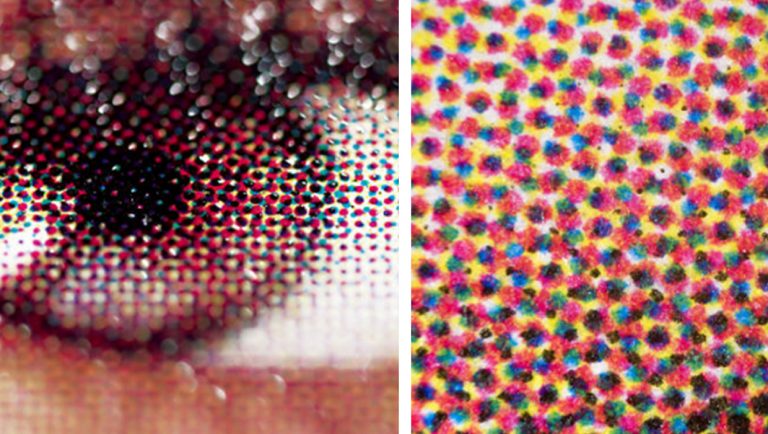
استفاده از مدل رنگ CMYK راه کاری را برای مشکل روشن تر بودن آبی دریایی، سرخابی و زرد نسبت به قرمز، سبز و آبی ارائه می کند. CMYK در مقایسه با RGB می تواند بیشتر طیف رنگ های روشن تر را راحت تر پوشش دهد. با این وجود، در حالی که CMYK به خودی خود نمی تواند رنگ های بسیار تیره تری مانند “مشکی واقعی” را بوجود بیاورد، مشکی ( “K” برای “رنگ کلیدی” ) به CMYK افزوده می شود تا در مقایسه با RGB، طیف گسترده ای از رنگ ها بدست بیاید.
آیا تبدیل مدل رنگ فایل طراحی به CMYK از اهمیت برخوردار است؟
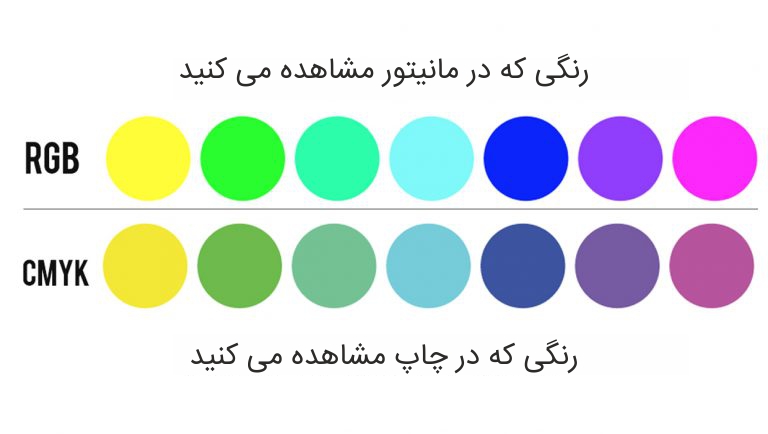
بله و خیر. حتی بدون دخالت بیشتر، اغلب پرینترها به صورت اتوماتیک و بدون اینکه بدانید داده های RGB را به CMYK تبدیل می کنند. سایت printplace.com نیز این تبدیل را به صورت اتوماتیک انجام می دهد. در اکثر موارد، تبدیل فایل بدست خودتان چندان الزام آور نیست. در “رازهای طراحی”، دیوید بلَتنِر تشریح می کند که چرا تبدیل RGB به CMYK در قرن بیست و یکم معمولا الزام آور نیست ( بویژه در موارد استفاده از Adobe InDesign ).
با این وجود، ما پیشنهاد می کنیم که پروژه خود را با CMYK آغاز و یا به چند دلیل مشخص قبل از فرستادن برای پرینت گرفتن، آن را از RGB تبدیل کنید. تغییر ظاهری رنگ از RGB به CMYK در بسیاری از موارد می تواند شدید باشد ( مانند زمانی که اثر هنری شما دارای میزان زیادی رنگ قرمز روشن است ). اگر بدنبال بالاترین دقت رنگی در پرینت های نهایی خود هستید، می بایست قبل از تحویل کار، به صورت یکپارچه مدل های رنگی را برای فایل های طراحی خود مشخص کنید. این مسئله ممکن است در مواردی که رنگ ها به طور مشخص بر اساس کد شش تایی رنگ ها و نمونه رنگ مرتب شده اند حیاتی باشد. در چنین مواردی، باید مطمئن شوید که مدل های صحیح رنگ را انتخاب کرده اید.
تنها زمانی که به تبدیل به CMYK نیازی نخواهید داشت هنگامی است که پاکت های تک رنگ را با رنگ های آبی بازتابی یا رنگ های قرمز نقطه ای استاندارد سفارش دهید.
چگونه فایل خود را به CMYK تبدیل کنم؟
ما در این بخش قدم به قدم به شما می گوییم که در نرم افزارهای مختلف، چگونه می توانیم فرمت رنگی ( مود رنگی ) کار خود را از RGB به CMYK تبدیل کنید.
تبدیل RGB به CMYK در نرم افزار Adobe Photoshop CS6 :
برای تبدیل مود رنگی RGB به CMYK در نرم افزار فتوشاپ، مراحل زیر را طی نمایید.
1- فایل یا آبجکت مورد نظر خودتان را انتخاب کنید.
2- بر روی “image” کلیک نمایید.
3- گزینه “Mode” را انتخاب نمایید.
4- گزینه “CMYK Color” را انتخاب نمایید.
تبدیل RGB به CMYK در نرم افزار Adobe Illustrator CS6 :
برای تبدیل مود رنگی RGB به CMYK در نرم افزار ایلوستریتور، مراحل زیر را طی نمایید.
1- فایل یا آبجکت مورد نظر خودتان را انتخاب کنید.
2- بر روی “Edit” کلیک نمایید.
3- “Edit Colors” را انتخاب کنید.
4- “Convert to CMYK” را برگزینید.
تبدیل RGB به CMYK در نرم افزار Corel Draw :
برای تبدیل مود رنگی RGB به CMYK در نرم افزار کورل دراو، مراحل زیر را طی نمایید.
1- فایل با آبجکتی که میخواهید مود رنگی اش را تغییر دهید انتخاب نمایید.
2- بر روی ابزار “Fill” کلیک نمایید.
3- کادر محاوره ای “Fill Color” را انتخاب کنید.
4- بر روی “CMYK” کلیک کنید.
5- در نهایت “OK” را بزنید.
برای تغییر اشیاء ( آبجکت ها ) با طرح کلی، همان فرآیند را تکرار نمایید.
1- بر روی ابزار “Outline” کلیک نمایید.
2- از کار محاوره ای “Outline Color” را انتخاب نمایید.
3- بر روی “CMYK” کلیک کنید.
4- در نهایت “OK” را بزنید.
لینک منبع : Why Printing Uses CMYK ترجمه شده توسط چاپ روشا


